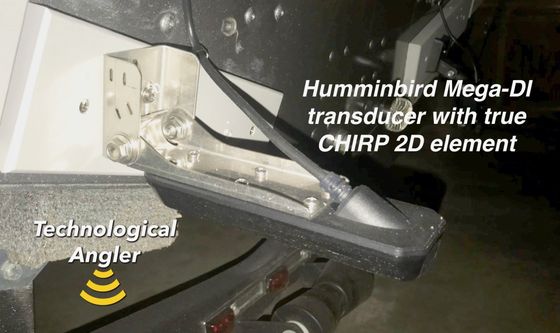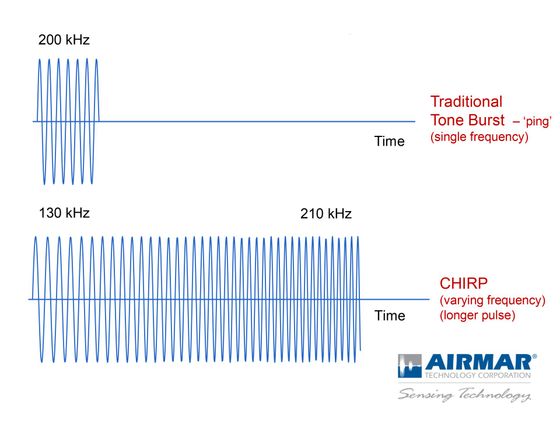CHIRP transducers and the Q factor

In recent years, CHIRP sonar has become commonplace on both small and big boats alike. CHIRP is an acronym that stands for Compressed High Intensity Radar Pulse, and is a way of producing and transmitting the sonar signal into the water. CHIRP is perhaps best understood by comparing CHIRP sonar to a single frequency sonar transmission.
A single frequency sonar transmission is illustrated on the top of this figure. As you can see, only one sonar frequency (200 kHz) is broadcast, and the transmission time is small. A CHIRP sonar transmission is shown on the bottom. Here, the sonar frequency changes during the transmit pulse, starting (in this case) at 130 kHz and ending at 210 kHz. Moreover, the transmission lasts much longer.

Since the introduction of CHIRP, anglers have begun to enjoy its benefits, including (1) enhanced depth penetration, (2) better resolution/target separation, (3) better signal to noise ratios, which lead to cleaner displays, and (4) better-defined arches for fish returns in 2D sonar. Each of these benefits is rooted in the ways that CHIRP sonar is transmitted from the transducer, and subsequently, the ways that the CHIRP sonar echoes are processed on the control head.
Now, in Humminbird HELIX G3N and SOLIX G2 units, CHIRP sonar performance has been elevated and optimized with the introduction of custom, low-Q true CHIRP 2D sonar transducers that transmit and receive sonar data in ways that have not been possible previously. These new transducers replace the high-Q 2D sonar transducers that have been available with previous generations of HELIX and SOLIX units. The difference between low-Q and high-Q transducers is rooted in (1) the usable frequency spectrum that each can transmit, and (2) how quickly the transducer can switch from transmit to receive modes.
In general terms, a low-Q transducer has a larger bandwidth: it is able to transmit a broader range of frequencies around the central frequency and have useful sonar intensity throughout that range. Remember that only a fraction of the sonar beam’s original transmit power is ever returned by a sonar echo, so having enough intensity throughout the CHIRP range is important for realizing the maximum benefits of CHIRP sonar. An illustration of a low-Q transducer’s effective CHIRP range is shown as the red curve in this figure; the dashed line is the central transmission frequency (imagine that this is 200 kHz), and substantial transmission intensity on either side of this central frequency means that these other frequencies are also broadcast into the water to a significant degree.

This behavior is in contrast to a high-Q transducer, shown as the blue curve. Typically, high-Q transducers are excellent at transmitting the central frequency and can also CHIRP in a relatively narrow range; however, frequencies that are very different from the central frequency are not transmitted with high intensity: they will not contribute in a meaningful way to the sonar echoes received by the transducer and displayed to the user.
The amount of ringing of the transducer element also differentiates low-Q and high-Q transducers. Ringing describes the length of time that the transducer element continues to produce sound waves after the transmit pulse has been turned off; think about this as the long sound produced by a bell long after the clapper has hit the bowl of the bell. When the transducer element is ringing, it cannot receive sonar echoes. Significant ringing means that the transducer is inefficient at receiving echoes from close range: the bottom in shallow water or objects that are very high in the water column. A low-Q transducer minimizes the time that the transducer element is ringing, while high-Q transducers have a longer amount of ringing time. From the user’s perspective, this means that a low-Q transducer will be able to transmit more frequently during any given period of time; this is because ringing has been minimized, allowing the transducer to switch between transmit and receive modes more rapidly. Reduced ringing also means that shallow water performance will be enhanced in a low-Q transducer relative to a high-Q transducer
Low-Q true CHIRP transducers have arrived across the Humminbird family of fish finders, and anglers will soon be able to harness the maximum benefits of CHIRP sonar every time they hit the water.
The amount of ringing of the transducer element also differentiates low-Q and high-Q transducers. Ringing describes the length of time that the transducer element continues to produce sound waves after the transmit pulse has been turned off; think about this as the long sound produced by a bell long after the clapper has hit the bowl of the bell. When the transducer element is ringing, it cannot receive sonar echoes. Significant ringing means that the transducer is inefficient at receiving echoes from close range: the bottom in shallow water or objects that are very high in the water column. A low-Q transducer minimizes the time that the transducer element is ringing, while high-Q transducers have a longer amount of ringing time. From the user’s perspective, this means that a low-Q transducer will be able to transmit more frequently during any given period of time; this is because ringing has been minimized, allowing the transducer to switch between transmit and receive modes more rapidly. Reduced ringing also means that shallow water performance will be enhanced in a low-Q transducer relative to a high-Q transducer
Low-Q true CHIRP transducers have arrived across the Humminbird family of fish finders, and anglers will soon be able to harness the maximum benefits of CHIRP sonar every time they hit the water.